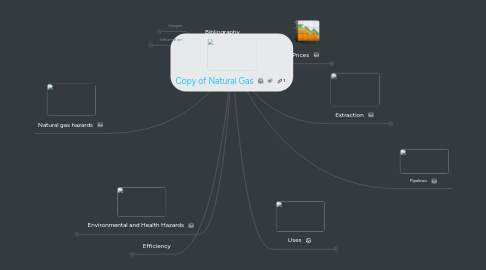
1. Bibliography
1.1. Images
1.1.1. http://www.2b1stconsulting.com/natural-gas/
1.1.1.1. 2b1srt consulting
1.1.2. www.c2es.org
1.1.2.1. Leveraging Natural Gas to Reduce GHG Emissions
1.1.3. http://strangesounds.org/2013/02/controversial-natural-gas-extraction-fracking-will-play-a-central-role-in-the-next-german-election-campaign.html
1.1.3.1. Dangers of fracking: Fracking will play a central role in the next German election campaign(strange Sounds)7
1.1.4. http://www.aiche.org/resources/chemeondemand/webinars/safety-lng-value-chain
1.1.4.1. Safety in the LNG Value Chain (AlChE)
1.1.5. http://c03.apogee.net/contentplayer/?coursetype=kids&utilityid=gcpud&id=16198
1.1.5.1. Natural Gas Uses (Kids Korner)
1.1.6. http://blog.jess3.com/2013/04/scrolling-through-the-story.html
1.1.6.1. Domestic consumption
1.2. Information
1.2.1. http://www.youtube.com/watch?v=lB3FOJjpy7s
1.2.1.1. Hydraulic Fracturing- Shale Natural Gas Extraction(YouTube)
1.2.2. http://www.ontarioenergyboard.ca/OEB/Consumers/Natural+Gas/Natural+Gas+Rates
1.2.2.1. Natrural Gas Rates (OED)
1.2.3. http://www.environmentalhealth.ca/summer01gas.html
1.2.3.1. The Health Hazards of Natural Gas (EHANS)
1.2.4. http://toxtown.nlm.nih.gov/text_version/chemicals.php?id=18
1.2.4.1. Tox Town
1.2.5. http://www.epa.gov/airquality/oilandgas/basic.html
1.2.5.1. Oil and Natural Gas Air Pollution Standards(EPA)
1.2.6. http://www.naturalgas.org/environment/naturalgas.asp
1.2.6.1. Natural Gas and the Environment (Natural Gas.org)
1.2.7. http://www.theglobeandmail.com/report-on-business/industry-news/energy-and-resources/natural-gas-winning-the-race-for-energy-efficiency/article4465567/
1.2.7.1. Natural gas winning the race for energy efficiency (The Globe and Mail)
1.2.8. http://www.naturalgas.org/overview/uses.asp
1.2.8.1. Uses Of Natural Gas (Natural Gas.org)
1.2.9. http://www.naturalgas.org/overview/uses_residential.asp
1.2.9.1. Residential Uses (Natural Gas.org)
1.2.10. http://www.naturalgas.org/overview/uses_commercial.asp
1.2.10.1. Commercial Uses (Natural Gas.org)
1.2.11. http://www.naturalgas.org/overview/uses_industry.asp
1.2.11.1. Uses In Industry(Natural Gas.org)
2. Natural gas hazards
3. Environmental and Health Hazards
3.1. Linked to increased asthma, respiratory illness, and impaired lung function
3.2. Significant contributors to chemical contamination
3.3. Worsen both classical allergy and chemical sensitivity.
3.4. Release of greenhouse gases which contribute to climate change.
3.5. Exposure to extremely high levels of natural gas can cause loss of consciousness or even death.
3.6. Contribute to the formation of ground-level ozone (smog)
4. Efficiency
4.1. Most efficient fossil fuel.
4.2. Produces the least amount of GHG
4.3. The average efficiency of natural gas plants have improved continuously over the past 10 years
4.4. approximately 44%
4.5. Fuel of the future because it allows producers to extract cheaply and technology allows consumers to use it more sparingly
5. Prices
5.1. Natural Resource Gas Limited
5.1.1. 18.6596 ¢/m3
5.2. Union Gas Limited
5.2.1. 12.2925 ¢/m3
6. Extraction
6.1. A well is drilled through several layers of Earth until it reaches the shale layer approximately 6000 ft. below the ground. After the shale layer is reached the drill then digs 1000-3000 ft horizontally into the shale.
6.2. When the drilling is complete the mud solution and cuttings are sucked out of the hole and the drill is removed.
6.3. Steel casing is fed through the length of the entire well and secured into place by cement. the cement is pumped through the pipe with enough pressure that it ends up surrounding the pipe and doesn't end up within the steel casing..
6.4. The drill then re-enters the well where it drills through the cement and into the shale. The mud solution and cuttings are once again sucked outside of the well.
6.5. A perforated pipe gun is sent down and out of the casing where explosives are fired into the shale. Fracturing fluid (water and sand) is pumped down the well and into the fractures. the fractures crack, expand and allow the natural gas to be extracted.
6.6. The fluid is then pumped out of the well and the perforated pipe is slid down the well. A plug is put in between the pipe and the fractured shale. The process is then repeated for the entire length of the well hole.
6.7. Once the process is completed the plugs are removed and the natural gas can be extracted.
7. Pipelines
8. Uses
8.1. In the past Natural gas was used to in streetlamps or to light up the occasional house
8.2. Residential
8.2.1. Most affordable form of energy
8.2.2. Heating
8.2.3. cooling
8.2.3.1. natural gas air conditioners
8.2.4. cooking
8.2.5. Distributed Generation
8.2.5.1. generate electricity right at the doorstep
8.3. Commercial
8.3.1. space heating
8.3.2. water heating
8.3.3. Cooling
8.3.4. cooking
8.3.5. distributed generation
8.3.6. Drying
8.3.7. lighting
8.4. Industrial
8.4.1. base ingrediant
8.4.1.1. plastic
8.4.1.2. fertilizer
8.4.1.3. anti-freeze
8.4.1.4. fabrics
8.4.1.5. pharmaceutical products
8.4.2. lighting
8.4.3. processing
8.4.3.1. pulp and paper
8.4.3.2. metals
8.4.3.3. chemicals
8.4.3.4. petroleum refining
8.4.3.5. clay and glass
8.4.3.6. plastic
8.4.3.7. food
8.4.4. heating
8.4.5. cooling
8.4.6. cooking
8.4.7. waste treatment
8.4.8. incineration
8.4.9. metals preheating
8.4.10. glass melting
8.4.11. fueling industrial boilers

